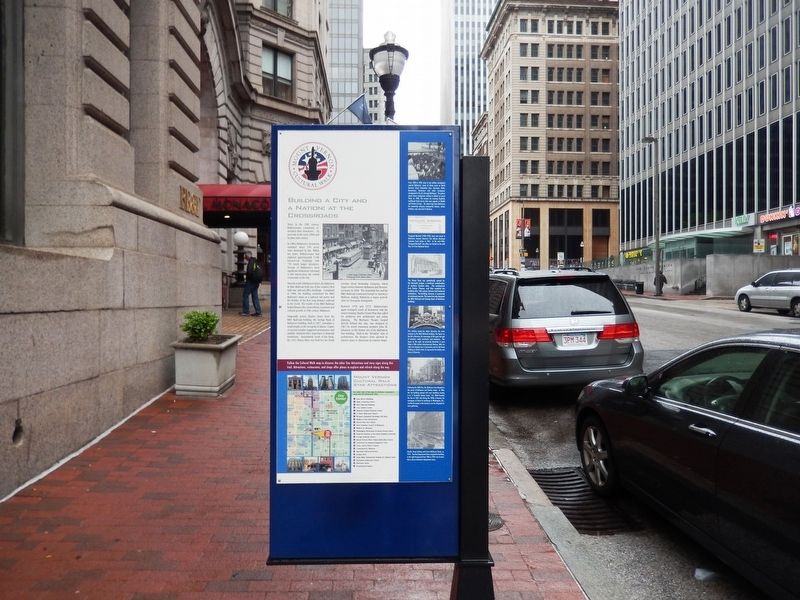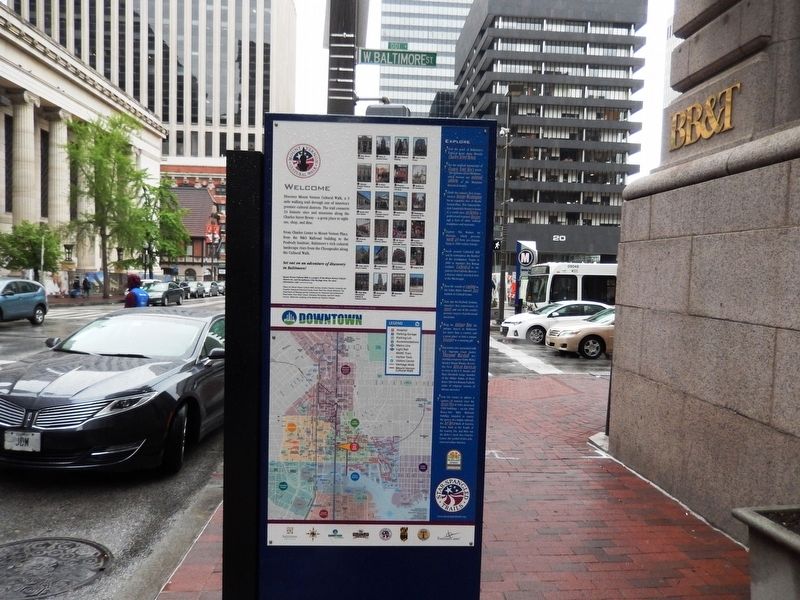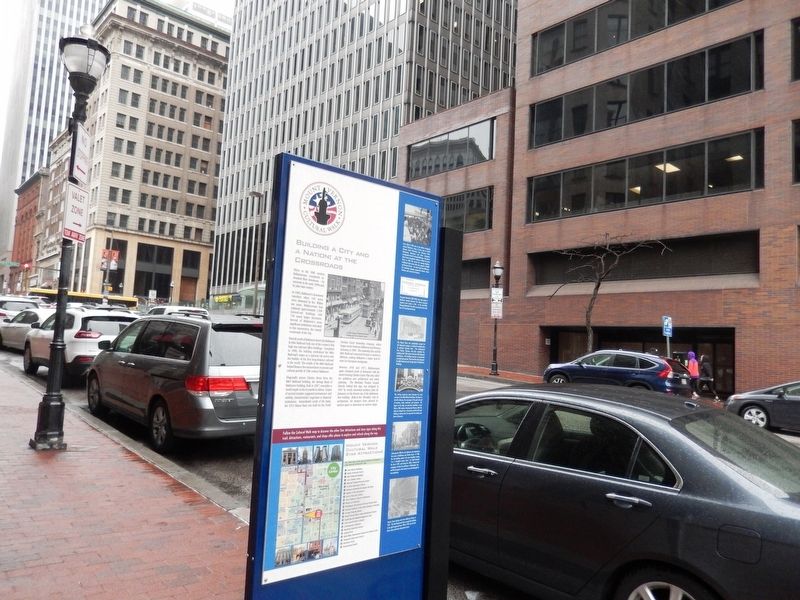Building a City and a Nation: At the Crossroads
Mount Vernon Cultural Walk
In 1904, Baltimore’s downtown vanished when 140 acres were destroyed by fire. Within ten years, Baltimore had replaced approximately 1,500 burned-out buildings with 750 much larger structures. Several of Baltimore’s most significant institutions relocated to this intersection, the central crossroads of the City.
Directly north of Baltimore Street, the Baltimore & Ohio Railroad built one of the country’s first high-rise railroad office buildings. Completed in 1906, the building symbolized the B&O Railroad’s status as a national rail power and the builder of the fist long-distance railroad in the world. The wealth of the B&O Railroad helped finance the extraordinary economic and cultural growth of the 19th century Baltimore.
Diagonally across Charles Street from the B&O Railroad building, the Savings Bank of Baltimore building, built in 1907, resembles a small temple on the Acropolis in Athens. Copies of ancient temples suggested permanence and stability, characteristics important to financial institutions. Immediately south of the bank, the 1912 Hansa Haus was built for the North German Lloyd Steamship Company, which began service between Baltimore and Bremen, Germany in 1868. The steamship
line and the B&O Railroad connected Europe to America’s Midwest, making Baltimore a major port-of-entry for European immigrants.Between 1958 and 1975, Baltimoreans again reshaped much of downtown with the award-winning Charles Center Plan that called for ambitious new architecture and urban planning. The Mechanic Theater, located directly behind this sign, was designed in 1967 by world renowned architect John M. Johansen on the former site of the Baltimore Sun building. Built in the “Brutalist” style of architecture, the theater’s form allowed its interior space to determine its exterior shape.
(Inscription under the images on the left)
(Image 1) From 1820 to 1920, close to two million immigrants entered Baltimore, many of whom came on North German Lloyd Steamship Line. Germans, Poles, Bohemians, Bavarians and other Europeans immigrated to the U.S. through Baltimore. The picture above shows immigrants waiting to debark at Locust Point, ca. 1904. The women are wearing Kopftuch, traditional head scarves that were popular in Middle and Eastern Europe. On return trips from Baltimore, the steamship company transported tobacco, wheat, fertilizer, coal, and steel to Bremen.
(Image 2) Thurgood Marshall (1908-1993), born and raised in Baltimore, became America’s first African American Supreme Court Justice in 1967. In the mid-1930s, Thurgood Marshall’s
(Image 3) The Hansa Haus was symbolically named for the Hanseatic League, a medieval confederation of northern German cities. The architectural firm Parker, Thomas, and Rice modeled the building after the 16th century German half-timbered architecture. The building however, is constructed of reinforced concrete. The same firm also designed the B&O Railroad and Savings Bank of Baltimore buildings.
(Image 4) This striking twenty-ton statue decorated the main entrance to the B&O Railroad building. The figure on the left is Mercury, the messenger of the gods and god of travelers, roads, merchants, and commerce. The figure on the right, not positively identified, is most likely a 20th century Americanized Mercury. With his right arm draped over a locomotive and is left hand holding an electric torch, he represents the vitality and future of America.
(Image 5) Following the 1904 Fire, the Baltimore Sun relocated to this corner of Baltimore and Charles streets. In 1906, the Sun building opened with news headlines touting it as “a Twentieth century home.” A.S. Abell founded the Sun in 1837, and during the 1840’s, it became the newspaper of choice for politicians in Washington D.C., and the first paper in the country to use the telegraph for news gathering.
(Image 6) Charles Street
Topics. This historical marker is listed in these topic lists: Architecture • Industry & Commerce. A significant historical year for this entry is 1904.
Location. 39° 17.381′ N, 76° 36.915′ W. Marker is in Baltimore, Maryland. It is in Downtown. Marker is at the intersection of North Charles Street and East Baltimore Street on North Charles Street. The marker is on the north west corner. Touch for map. Marker is in this post office area: Baltimore MD 21201, United States of America. Touch for directions.
Other nearby markers. At least 8 other markers are within walking distance of this marker. Inspired Words (about 400 feet away, measured in a direct line); Charles Center & One Charles Center (about 500 feet away); Mayor Thomas D'Alesandro, Jr. (about 500 feet away); Nancy D'Alesandro Pelosi (about 500 feet away); Cecilius Calvert (about 600 feet away); Baltimore College of Dental Surgery (about 700 feet away); Discover Baltimore’s Changing Skyline (about 800 feet away); To Commemorate the Inauguration of a Chemical Industry in America (approx. 0.2 miles away). Touch for a list and map of all markers in Baltimore.
Credits. This page was last revised on April 17, 2020. It was originally submitted on May 7, 2017, by Don Morfe of Baltimore, Maryland. This page has been viewed 219 times since then and 5 times this year. Photos: 1, 2, 3. submitted on May 7, 2017, by Don Morfe of Baltimore, Maryland. • Bill Pfingsten was the editor who published this page.


